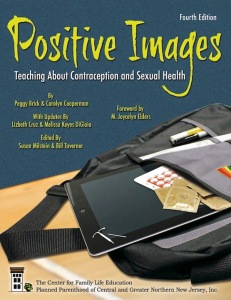As I mentioned earlier this week, there’s a lot of notable days in the sexology world right now. And what better way to celebrate THIS day of celebration than with a lesson from Positive Images: Teaching About Contraception and Sexual Health?
And as I always do when I start a new manual, we’re going to begin with the beginning, the first lesson:
_____________________________________________________________________
All Together Now:
Preventing Unplanned Pregnancy and Sexually Transmitted Infections
By Peggy Brick and Carolyn Cooperman
Objectives:
By the end of this lesson, participants will be able to:
- Identify their personal feelings about the relative risks for unplanned pregnancy and sexually transmitted infections (STIs).
- Compare the effectiveness of the major methods for protecting against unplanned pregnancy and STIs.
- Explain ways to integrate preventing unplanned pregnancy with preventing STIs.
Rationale
Many teens want to protect themselves from an unplanned pregnancy as well as from STIs. Unfortunately, popular and highly effective methods of contraception like the pill, patch, and Depo-Provera® do not protect against STIs. Yet many young people who use a condom the first time they have vaginal intercourse stop using condoms when they begin using hormonal contraception, making themselves vulnerable to STIs. This lesson helps teens assess their own risk for pregnancy and STIs, by stressing the importance of preventing both unplanned pregnancy and sexually transmitted infections.
_____________________________________________________________________
It’s always the conundrum, isn’t it? How to balance contraception with STI protection? Both are so critical to sexual health – really, you can’t go without either. But how can we support teenagers using double methods (hormonal and condoms), for example? This is really one of those questions that is timeless for sexuality educators. Throwing the issues of pregnancy and STI prevention into the same lesson plan is very effective. Comparing the methods and the risks and the costs has the potential to really change how teenagers evaluate their actions – and gives them tools to move forward with.
So two thumbs up! It’s a great start. I’ll be covering other lesson plans from Positive Images in the coming months – although next week I’m diving headlong into Making Sense of Abstinence. I’ve already started reading through it…deciding what to post about…because that’s the sort of thing I do in my free time. (“You may be a sex geek if…?”)






